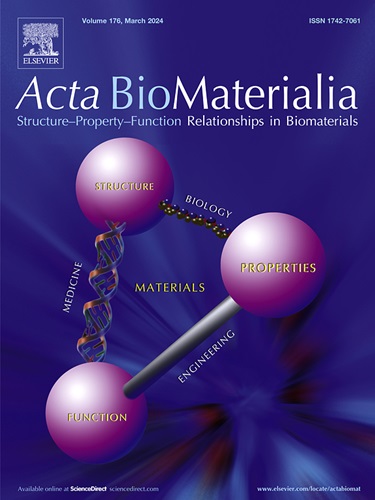Overcoming matrix barriers for enhanced immune infiltration using siRNA-coated metal-organic frameworks
IF 9.4
1区 医学
Q1 ENGINEERING, BIOMEDICAL
引用次数: 0
Abstract
The extracellular matrix (ECM) of solid tumor constitutes a formidable physical barrier that impedes immune cell infiltration, contributing to immunotherapy resistance. Breast cancer, particularly triple-negative breast cancer (TNBC), is characterized by a collagen-rich tumor microenvironment, which is associated with T cell exclusion and poor therapeutic outcomes. Discoidin domain receptor 2 (DDR2) and integrins, key ECM regulatory receptors on cancer cells, play pivotal role in maintaining this barrier. In this study, we developed a dual-receptor-targeted strategy using metal-organic frameworks (MOFs) to deliver DDR2-specific siRNA (siDDR2) and ITGAV-specific siRNA (siITGAV) to disrupt the ECM barrier. siDDR2 modulates immune infiltration by regulating collagen–cell interactions, while siITGAV suppresses TGF-β1 activation. The MOF@siDDR2+siITGAV complex significantly reduced collagen deposition, enhanced CD8+ T cell infiltration, and downregulated programmed cell death ligand 1 (PD-L1) expression in TNBC. Consequently, this approach markedly inhibited tumor growth. Our findings demonstrate that dual-receptor-targeted MOF-based nanocarriers (MOF@siDDR2+siITGAV) can effectively reprogram the tumor ECM to enhance immune cell access, offering a promising prospect for synergistic cancer immunotherapy.
Statement of significance
A dual-receptor-targeted MOF nanocarrier is developed to improve immune accessibility in tumors. Concurrent blockade of DDR2 and ITGAV effectively decreases collagen deposition, increases CD8+ T cell infiltration, and suppresses PD-L1 expression. Modulating the mechanical properties of the extracellular matrix (ECM) to enhance immune accessibility offers an innovative strategy for cancer treatment.

利用sirna包覆金属有机骨架克服基质屏障增强免疫浸润。
实体瘤的细胞外基质(extracellular matrix, ECM)构成了一个强大的物理屏障,阻碍免疫细胞的浸润,导致免疫治疗抵抗。乳腺癌,特别是三阴性乳腺癌(TNBC),其特点是富含胶原蛋白的肿瘤微环境,这与T细胞排斥和治疗效果差有关。盘盘蛋白结构域受体2 (DDR2)和整合素是肿瘤细胞上关键的ECM调节受体,在维持这一屏障中起关键作用。在这项研究中,我们开发了一种双受体靶向策略,使用金属有机框架(mof)递送ddr2特异性siRNA (siDDR2)和itgav特异性siRNA (siITGAV)来破坏ECM屏障。siDDR2通过调节胶原-细胞相互作用调节免疫浸润,而siITGAV则抑制TGF-β1的激活。MOF@siDDR2+siITGAV复合物显著减少TNBC中胶原沉积,增强CD8+ T细胞浸润,下调程序性细胞死亡配体1 (PD-L1)表达。因此,这种方法明显抑制肿瘤生长。我们的研究结果表明,基于双受体靶向mof的纳米载体(MOF@siDDR2+siITGAV)可以有效地重编程肿瘤ECM以增强免疫细胞的通路,为协同癌症免疫治疗提供了广阔的前景。意义声明:一种双受体靶向的MOF纳米载体被开发出来,以提高肿瘤的免疫可及性。同时阻断DDR2和ITGAV可有效减少胶原沉积,增加CD8+ T细胞浸润,抑制PD-L1表达。调节细胞外基质(ECM)的机械特性以增强免疫可及性为癌症治疗提供了一种创新策略。
本文章由计算机程序翻译,如有差异,请以英文原文为准。
求助全文
约1分钟内获得全文
求助全文
来源期刊

Acta Biomaterialia
工程技术-材料科学:生物材料
CiteScore
16.80
自引率
3.10%
发文量
776
审稿时长
30 days
期刊介绍:
Acta Biomaterialia is a monthly peer-reviewed scientific journal published by Elsevier. The journal was established in January 2005. The editor-in-chief is W.R. Wagner (University of Pittsburgh). The journal covers research in biomaterials science, including the interrelationship of biomaterial structure and function from macroscale to nanoscale. Topical coverage includes biomedical and biocompatible materials.
 求助内容:
求助内容: 应助结果提醒方式:
应助结果提醒方式:


